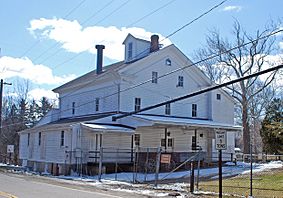Wolcott Mill Metropark facts for kids
Quick facts for kids Wolcott Mill Metropark |
|
|---|---|

Wolcott Mill
|
|
| Lua error in Module:Location_map at line 420: attempt to index field 'wikibase' (a nil value). | |
| Type | Regional park |
| Location | Lower Peninsula, Macomb County, Michigan USA |
| Area | 2,625 acres (1,062 ha) |
| Operated by | Huron–Clinton Metroparks |
| Status | Open year round |
| Website | Official site: http://www.metroparks.com/parks/wolcott-mill-metropark/ |
Wolcott Mill Metropark is a cool place to visit in Ray Township, Michigan. It's part of the Huron-Clinton Metroparks system. The park is special because the northern part of the Clinton River flows right through it.
Contents
Exploring Wolcott Mill Metropark
This big park covers about 2,625 acres (that's like 2,000 football fields!). There are lots of fun things to do here. You can explore many different areas and learn new things.
Trails and Outdoor Fun
Wolcott Mill Metropark has many trails for you to enjoy. If you like horses, there are 10 miles (16 km) of trails just for riding. There's also a large area that used to be a golf course. Now, it's a great place for walking and hiking.
The park also has "Camp Rotary." This is a special camping spot for groups of young people. It's a perfect place for outdoor adventures with your friends.
The Historic Wolcott Mill
The park is named after its old mill. The Wolcott Mill was built way back in 1847. It worked for a long time, until 1967. This mill was used to grind grain into flour (a grist mill) and to prepare food for animals (a feed mill).
What You Can See at the Mill
Today, you can still see the original machines inside the mill. They show how people used to make flour and feed. There are also exhibits and demonstrations. You can learn how the mill worked and what life was like back then.
The mill complex also has a barn museum. This museum teaches you about the history of American barns. You can see an old buggy and farming tools from the past. Many hiking trails in the park start near the mill, too.
The Working Farm at Wolcott Mill
Wolcott Mill Metropark has a real, working farm. It's about 250 acres big. This farm is home to many different animals.
Meet the Farm Animals
On the farm, you can see a herd of dairy cows. There are also chickens, goats, pigs, sheep, and horses. It's a great chance to see farm animals up close. The farm also grows different crops in its fields. This shows how food is grown and harvested.

